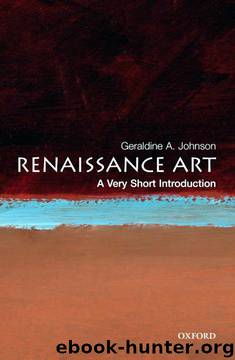Renaissance Art: A Very Short Introduction by Geraldine A. Johnson

Author:Geraldine A. Johnson [Johnson, Geraldine A.]
Language: zho
Format: epub
Tags: #genre
Published: 2010-10-26T16:00:00+00:00
20. Albrecht Durer, Self-Portrait, oil on panel, 1500
moved permanently to England, possibly in response to the religious iconoclasm he had witnessed in the Swiss city of Basel, his professional base for many years. Ironically, of course, by the later 1530s, England too would begin to dismantle its religious artistic heritage, beginning with Henry VIII's decision in 1536 to dissolve all Catholic monasteries and appropriate for himself, as head of the newly formed Church of England, their property, including any art that wasn't first destroyed by iconoclastic mobs.
But this was all yet to come when the 29-year-old patron of Holbein's great double portrait, Jean de Dinteville, wrote to his brother in May of 1533: `Monsieur de Lavaur did me the honour of coming to see me, which was no small pleasure to me.' Dinteville was the learned and noble-born French Catholic ambassador to the English court at the time that the Henry VIII was in the process of divorcing his wife Catherine of Aragon and marrying in her stead Anne Boleyn, a Protestant sympathizer the king hoped would finally give birth to a male heir. In the portrait, Dinteville stands on the left, with Georges de Selve on the right. Selve was not only Dinteville's close friend, but also the Bishop of Lavaur in the southwest region of France and a fellow French Catholic diplomat assigned to various European courts, including the papal court in Rome. Dinteville's letter refers to a secret visit by his friend at a time when the former was intensely homesick for France and, especially, for his family seat at the Chateau de Polisy not far from Paris. Significantly, the name of the chateau is inscribed at the centre of the terrestrial globe displayed on the lower shelf between the two men. We also know that, originally, Holbein's painting was hung in Polisy, presumably in one of the building's grand public rooms.
In addition to the globe, many other meticulously depicted objects are displayed on the two-tiered shelving unit. On the top level, there is a celestial globe of the heavens, together with a number of other scientific instruments related to astronomical measurements and time-telling, such as two quadrants and a sundial. On the lower shelf, besides the terrestrial globe, we also see an arithmetic book, a set of flutes in a case, a lute with one broken string, and a hymn-book. While this very diverse collection of items confirms that these are exactly the kinds of `universal' men so admired by Burckhardt, the objects on the lower shelf in particular suggest that the image may well be more than just a visual enumeration of the sitters' impressively varied interests. In fact, a number of items appear to evoke the theme of division and discord: the arithmetic book is open to a page headed with the Latin word for `divide' (dividirt), the hymn-book is a well-known German Protestant publication left open to a hymn associated with the controversial figure of Luther himself, while the lute's single broken string
Download
This site does not store any files on its server. We only index and link to content provided by other sites. Please contact the content providers to delete copyright contents if any and email us, we'll remove relevant links or contents immediately.
| Africa | Americas |
| Arctic & Antarctica | Asia |
| Australia & Oceania | Europe |
| Middle East | Russia |
| United States | World |
| Ancient Civilizations | Military |
| Historical Study & Educational Resources |
Room 212 by Kate Stewart(5010)
The Crown by Robert Lacey(4709)
Endurance: Shackleton's Incredible Voyage by Alfred Lansing(4653)
The Iron Duke by The Iron Duke(4269)
The Rape of Nanking by Iris Chang(4123)
Joan of Arc by Mary Gordon(4000)
Killing England by Bill O'Reilly(3936)
Say Nothing by Patrick Radden Keefe(3890)
I'll Give You the Sun by Jandy Nelson(3342)
Shadow of Night by Deborah Harkness(3277)
Hitler's Monsters by Eric Kurlander(3256)
Mary, Queen of Scots, and the Murder of Lord Darnley by Alison Weir(3133)
Blood and Sand by Alex Von Tunzelmann(3118)
Darkest Hour by Anthony McCarten(3057)
Eleanor & Park by Rainbow Rowell(3035)
Margaret Thatcher: The Autobiography by Thatcher Margaret(3020)
Red Famine: Stalin's War on Ukraine by Anne Applebaum(2856)
Book of Life by Deborah Harkness(2850)
The One Memory of Flora Banks by Emily Barr(2788)
